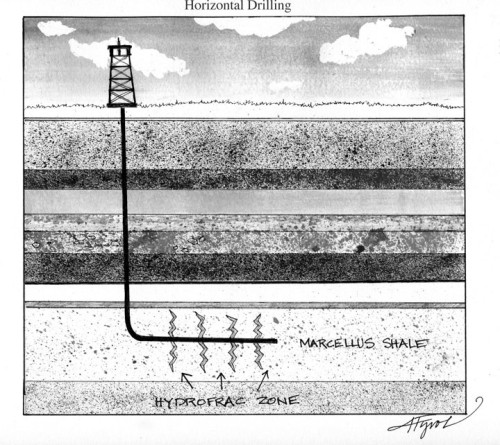
In case you missed it, there’s a natural gas explosion going on around us, not of the smoke and flames variety but rather of exploration and discovery. Enough natural gas has recently been confirmed in neighboring New York to potentially power the United States economy for years. Yes, that’s the entire United States, and yes, that’s years.
Is the boom about to come to Vermont and New Hampshire? In a word, no. And not because Vermont recently enacted a three-year moratorium on new drilling in the state.
Vermont and New Hampshire have been cursed (or blessed, depending on your point of view) with a lack of fossil fuel deposits, and it looks like we’re going to miss this latest bonanza as well. As with so many other features of these small, quirky states, you can blame it all on the mountains.
Crude oil and natural gas form under very specific geological circumstances. First you need a mountain range from which water is going to flow, carrying rich nutrients with it. Then you need an adjacent ocean or sea, preferably shallow, where plankton and algae can thrive in the nutrient-enriched waters and where their remains can filter to the bottom and slowly accumulate. Then you need an oxygen-poor environment so that the organic matter doesn’t preemptively decompose and disappear. Then you need a whole bunch of time.
During all this time, the carbon-rich sediments become buried under evermore silt and sand as the nearby mountains continue to erode. Eventually, the weight of the sediments grows heavy enough to convert the ooze into oil and, if the pressure and resulting heat are intense enough, into natural gas.
In other words, if you want to find rich deposits of oil and natural gas today, look on the flanks of where the mountains are (or used to be). In our case, those mountains would be the Appalachians, and those flanks are either the deep inland basin (and former sea) that runs down the western side of the range, from Quebec to New York to Pennsylvania and beyond, or the offshore continental shelf, presently under the Atlantic Ocean, where oil and gas have also been found. But don’t look in the core of the mountains themselves because they were the source, not the sink, for the sediments.
If you drew a line through northern New England along the center of the old Appalachian range, you’d draw it right across New Hampshire, from southwest to northeast. There’s scarcely a sedimentary rock to be found in the entire state – it’s the land of the granites and metamorphics. You can’t be both the Granite State and the Natural Gas State, so no go in New Hampshire.
Vermont is a more complicated story. While the eastern side of the state is close to the core of the range, the western side, including the Champlain Valley and the Valley of Vermont, abuts the inland basin. In fact, these valleys are geologically part of the inland basin, and the Essex shale found in Vermont, for example, has produced natural gas farther west in New York. So Vermont could, in theory, have some natural gas.
But to have natural gas, you also need to have just the right combination of geological formations: a relatively porous formation (like the Essex or Marcellus shale) where the gas can accumulate, and a non-porous trap rock (like a sandstone) to act as a lid and trap the gas underneath instead of allowing it to seep away and disperse.This layer cake of formations needs to be intact, but the closer you get to the mountains, the more likely it is that these layers were broken or folded long ago, allowing the gas to escape.
Drilling for natural gas has not yet been done in Vermont, so it’s impossible to say for sure whether there is any to be found. But given the fractured bedrock of Vermont’s mountainous topography, it’s not likely to be there, especially in commercially viable quantities.
But that’s the final piece of the story – the changing definition of “commercially viable quantity.” The natural gas in the Marcellus shale wasn’t recently discovered; geologists have known about it for decades. But they couldn’t get to it until they had the new tools of horizontal drilling and hydrofracking.
In other words, technology changes, so never say never. But mountains don’t change, at least over human lifetimes. If someone tries to sell you shares in the Vermont and New Hampshire Natural Gas Company, you’d be much better off keeping your cash under the mattress.


Discussion *